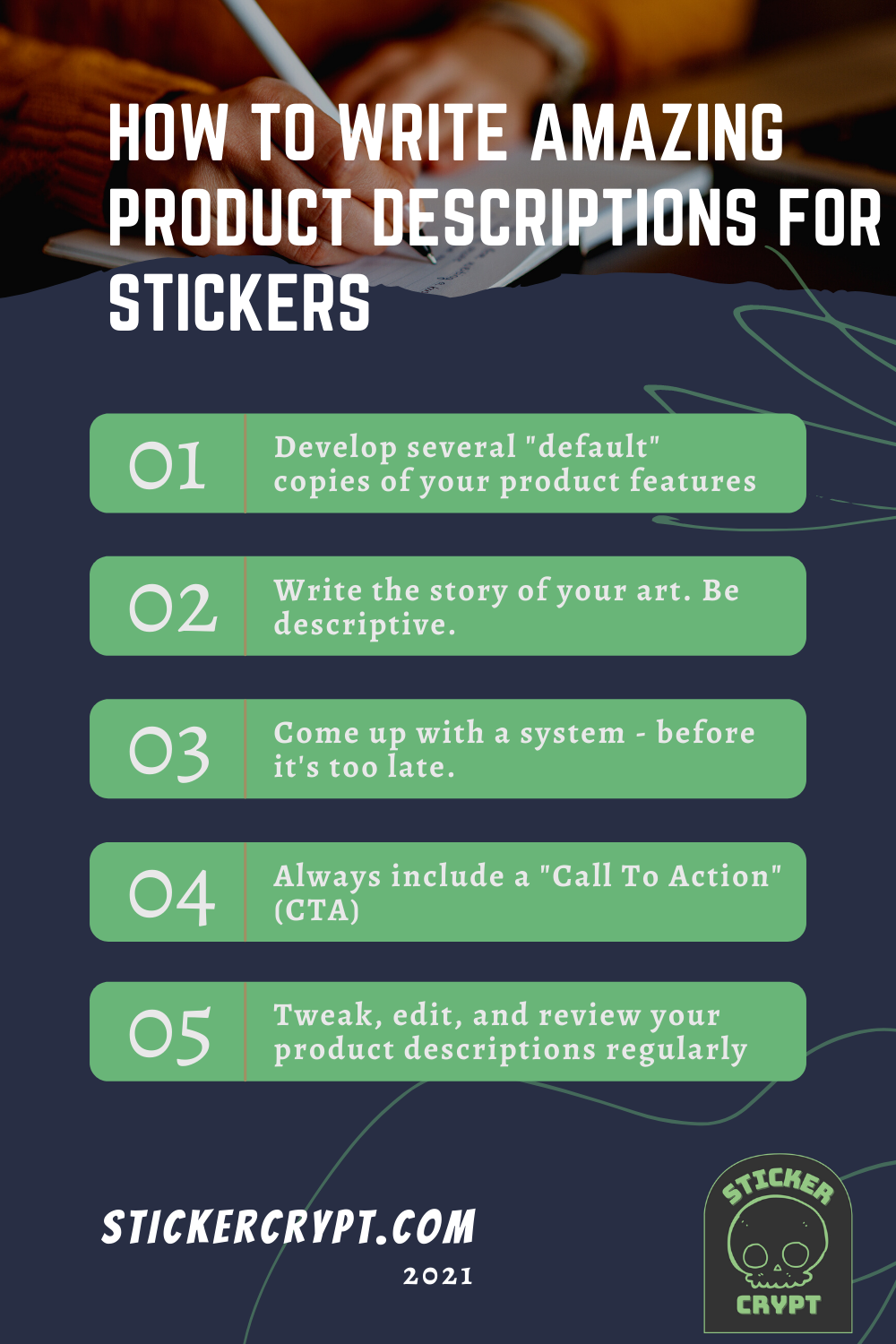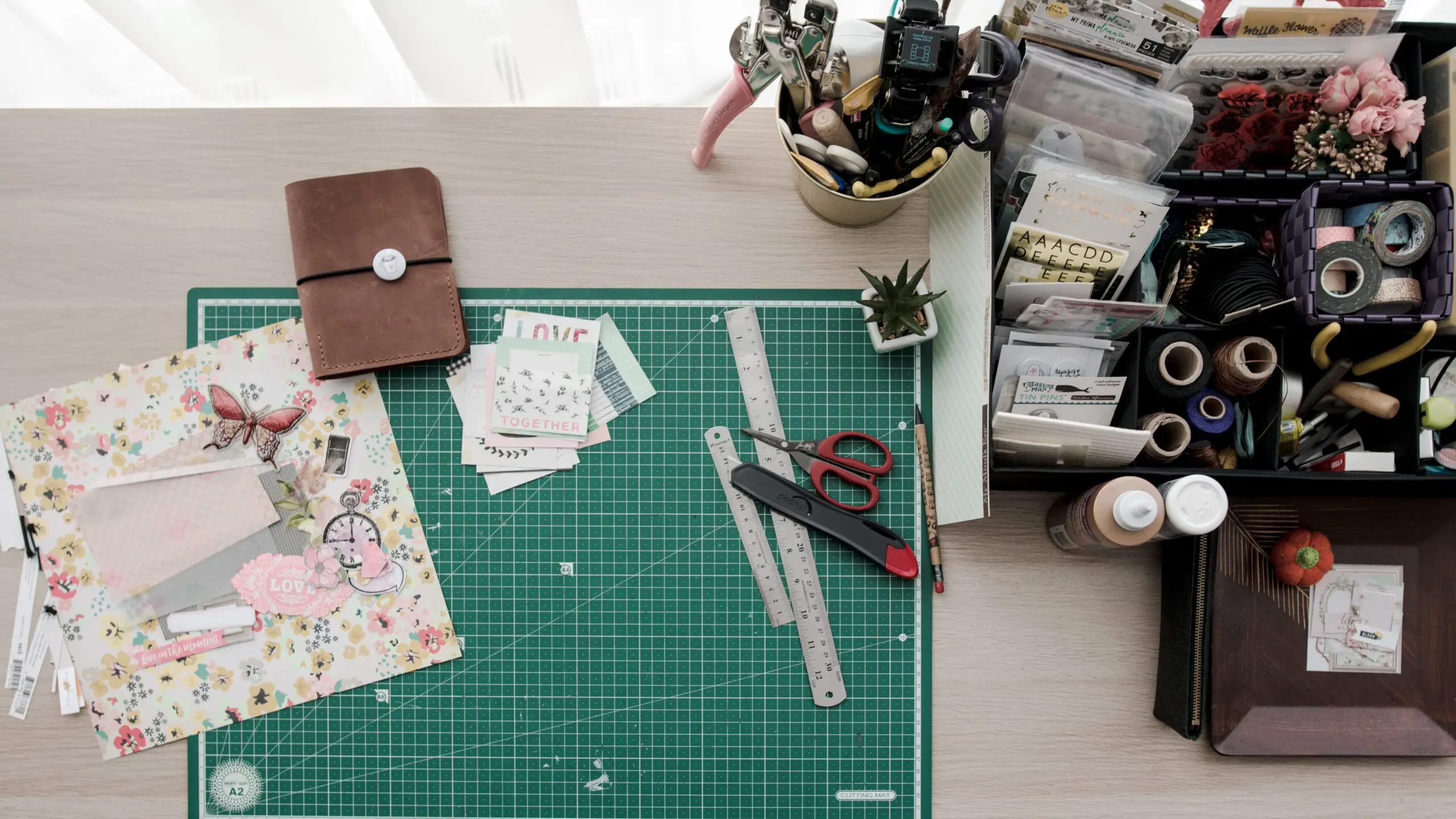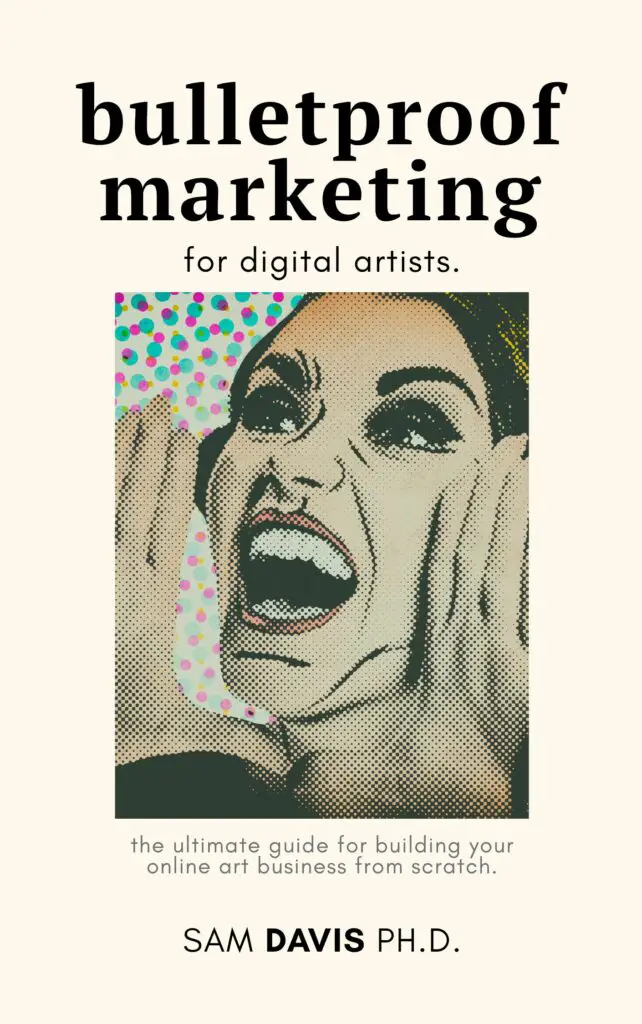There's a dirty little secret about e-commerce that most craft sellers don't know: making your products is only half the battle. Understanding how to write amazing product descriptions for stickers, pins, or other items can be hard, but we're here to help. Let's get started!
Writing product descriptions is about making compelling copy for both your customers AND for search engines. Because your customers won't find you without the search engines. So be sure to write for whatever platform you're selling on.
Step 1: Develop several “default copies” of your product features
When it comes to small items like stickers, pins, magnets, and even keychains and ornaments, the selling feature is actually your design elements – not the product itself. You're not creating a new kind of sticker, you're creating the art that goes on the sticker. But, when we write our product descriptions, we tend to overly focus on the product materials, not the art. This can result in some pretty bad writer's block, and lead to poor descriptions.
However, you can't write a product description without having some descriptions of the physical features. For stickers, it's important to write out what materials you use, what your process is, what longevity they can expect, what the stickers are best used for, and whether or not they're waterproof. These are the things that do matter to customers, so having them front and center is important.

Write amazing product descriptions with bulleted lists of features
So, make a bulleted list of the features that your items have. Aim for 3-6 bullet points, and put the important words up front. It'll depend on the platform that you're using as to whether or not you can create emphasis, but regardless, you want it to be easy to skim for your customers. This is a great example of what I mean by emphasis:
- Waterproof. Take these babies swimming because all stickers that we produce are waterproof!
- Hard to rub off. Our stickers aren't invincible, but they're close.
- Warrantied. How many sticker producers offer you a 3-month warranty? We do! If your sticker is rubbing down, let us know – we'll be happy to replace it.
- Unique. All of our art is produced in house, meaning that you get unique designs found nowhere else. Let your individuality shine!
- Vinyl. We believe vinyl is one of the most durable materials out there, which is why we use vinyl – not polyester – to produce our stickers.
- Strong. Our stickers are a little hard to peel, but that's because their tack is STRONG – just the way you like it.
If you can't emphasize with bold, you can use all caps – like I did with the word strong. Take some time to develop your first set of bullet points, and it'll serve you well.
And, when you're done with that, do it again. Reshuffle the order of points, rephrase what you were saying. Shoot for 3-5 copies of your default product details, because this will keep your website feeling slightly fresher for customers. As you grow and analyze, you might find that one set of bullet points performs better than another. Or, you might find that certain bullet points appeal to different audiences. You can mix and match while you optimize for the best fit. Finally, different marketplaces have different formatting and word count requirements. So, having a few different copies of your default text helps you out when you're cross-posting items.
Step 2: Write the story of your art.
You don't need an entire blog devoted to each design, but it would certainly help with search engine optimization (SEO). SEO is a method of finetuning the things you put on the internet so that search engines like them. Humans like images, but search engines? Search engines like text. So, be sure to give them text. Shoot for a paragraph or two for each of your products, in addition to the bullet points, and you'll be set up for success. Here are some ideas to fill the space:
- What inspired you to create this piece of art?
- Who do you envision will love and use this art?
- Do you have a personal story about this art?
- How long did this art take you to create?
- What platform or tools did you create this art with?
- Do you have any regrets?
- What do you love about the piece?
- When did you create it?
If you're an overachieve, you could create two or three copies of this description, as well. This might be useful for optimizing, or maybe you want a longer piece for a blog and a shorter piece for your product description. Or, maybe you're just a masoch1st. Who really knows?
Step 3: Come up with a system to write amazing product descriptions – before it's too late.
Don't leave your product descriptions out in the wind to rot. Seriously. When you're producing left and right, as is common with stickers, you need a system right away to categorize your art and save all of your descriptions and files for easy access. I use Google Sheets for details and Google Drive for files, but AirTable and ClickUp are both good organizational services that can help you for low- or no cost.
When you have 200 sticker designs and you're looking at revamping product descriptions, it can be really, really daunting. Before you get started on a revamp, ask yourself: are these items selling ok? If not, is it really because of the description, or is the art mediocre? Culling and cultivating your collection may provide better dividends than trying to lighten up a mediocre design with some awesome writing.
If you do decide to go ahead with a revamp, just tackle a few designs at a time. You don't want to burn yourself out, and you don't want to take too much away from your creative time. We're in the business to have fun, create, and make money – not kill ourselves with copyediting. If you can hire someone to do it for you, go with that instead. It'll save you some stress.
Step 4: Always include a call to action
The call to action, or CTA, is a push for your customers to take action. CTAs are well known across both the business and nonprofit world. It's common knowledge on websites that most pages should have some sort of CTA. Give your customer somewhere to go or something to do, because your customer (and I) is basically a lab rat exploring its surroundings. You click the buttons, you know you do. So do I. So give that opportunity to your customer.
For product descriptions on Etsy and Amazon Handmade, you can't give them a literal button. But you can convey a sense of urgency, or convince your customer what a great gift or must-have your sticker is. Be sure to include that text so that your customer takes the leap.
Write amazing product descriptions with a clear call to action
Heck, if you don't want to revamp a large library of product descriptions, but want to do something – including a CTA in each product description is your best time spent. CTAs can freshen up even the most boring description. Here are a few boilerplate examples for inspiration:
- Your mom will LOVE these new planner stickers – don't wait!
- Here today, gone tomorrow – get yours before this design sells out!
- Share a piece of history with your best friend, and remind them of all the good times you've had with this present.
- There are worse ways to spend your money, friend, so support a starving artist and buy my stuff!
I'm not saying these will seal the deal, but they're a good start. If you're balking at my style, try snooping on a few competitors websites and see if you can identify their call to action text and buttons – what do they say? How do they make you feel? Understand your own feelings, and you'll understand CTAs.
Step 5: Tweak, edit, and review your product descriptions regularly
You don't need to do it as much as you brush your teeth, but as you grow, you'll have a better idea of what works and what doesn't. So revisit your product descriptions once in a while to see if you can't freshen them up a little.
Got questions about product descriptions? We can help! Leave your questions down in the comments! (P.S. – that's a CTA!)


